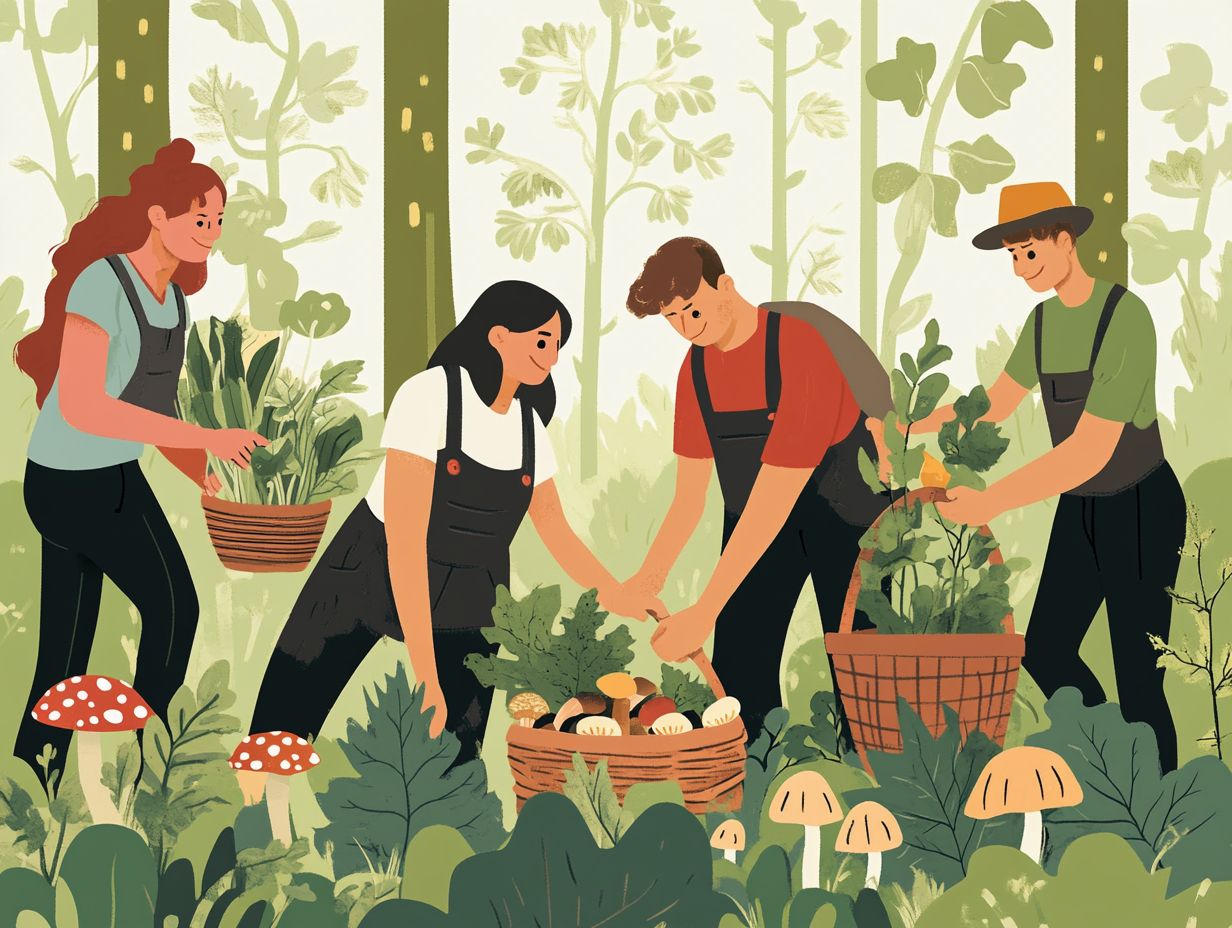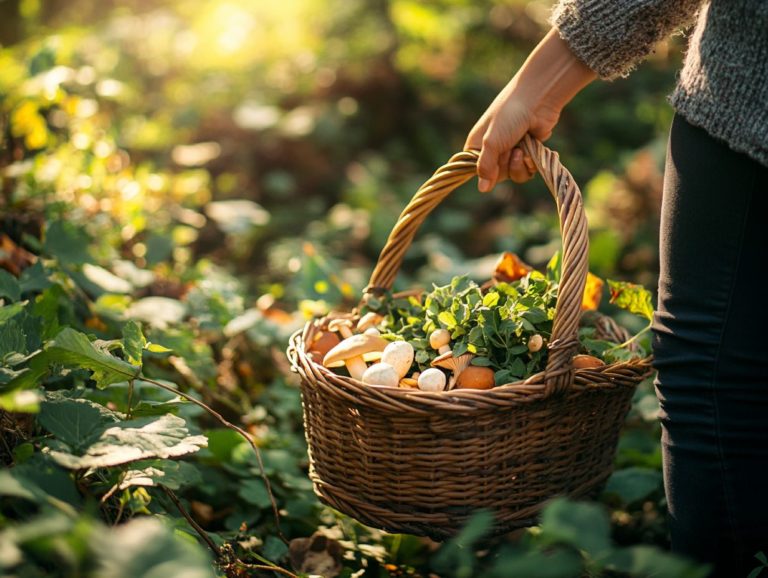The Art of Collaborative Foraging Techniques
Collaborative foraging is a captivating practice that allows individuals to unite in the pursuit of food. This significantly enhances both efficiency and success.
This article delves into the core principles of collaborative foraging, shedding light on its many benefits for individuals and groups.
From techniques involving team-based hunting and gathering to the communication strategies that underpin success, you ll discover everything necessary to incorporate these practices into your life.
Join us on an exciting journey to master the art of foraging!
Contents
Key Takeaways:

- Collaborative foraging helps groups gather resources efficiently.
- You gain better access to food and strengthen social bonds.
- Techniques include group hunting, resource sharing, and effective communication.
The Basics of Collaborative Foraging
Collaborative foraging stands as an enriching practice that beautifully blends food sustainability, environmental education, and community involvement. It invites you to engage in the gathering of wild foods and raw ingredients. This nurtures a profound appreciation for local flora and ecosystems.
This approach encourages knowledge sharing and fosters experiential learning, elevating your culinary exploration and ecological awareness.
By immersing yourself in collaborative efforts within your community, you can cultivate connections to cultural identity and traditional knowledge. This ultimately establishes a sustainable relationship with nature s abundant offerings.
What is Collaborative Foraging?
Collaborative foraging is all about gathering wild ingredients as part of a community. It is deeply rooted in principles of sustainability and considering how living things interact with each other and their environment.
This distinctive practice emphasizes teamwork and the sharing of knowledge. It invites you to explore diverse habitats alongside others, learning together about the seasonal availability of flora and fauna.
At its core, collaborative foraging respects nature’s delicate balance. It ensures that resources are harvested ethically while cultivating a genuine appreciation for local ecosystems.
During these enriching trips, you may gather a delightful array of wild ingredients, including edible plants, mushrooms, fruits, and herbs. Each brings essential nutrients and unique flavors to your table. Unlike traditional foraging, which often has you going it alone based on personal experience, collaborative foraging highlights the importance of group learning.
This approach enables you and fellow participants to collectively identify and embrace sustainable practices while fostering a strong sense of community.
Benefits of Collaborative Foraging
The benefits of collaborative foraging are substantial. They extend from improved food sustainability to enriching community appreciation and knowledge through shared foraging endeavors.
These collective efforts not only strengthen bonds among participants but also have a meaningful impact on environmental dynamics.
Ready to explore the world of collaborative foraging? Let’s get started!
Advantages for Individuals and Groups

Collaborative foraging offers a wealth of benefits for you, whether you engage individually or as part of a group. It enhances your social information exchange and deepens your understanding of environmental education and cooking style.
Participating in this shared activity can lead to personal growth, helping you appreciate your local ecosystems and the natural world around you. This heightened ecological awareness fosters a strong sense of responsibility toward sustainability, allowing you to explore your cooking style through discovering local edible plants and fungi.
You ll forge meaningful social bonds at the community level, exchanging stories and knowledge that strengthen connections among participants. These relationships often blossom into collaborative cooking experiences, blending diverse culinary traditions to create not just meals, but memorable gatherings that celebrate both nature and culture.
Examples of Collaborative Foraging Techniques
Collaborative foraging techniques encompass practices such as organized group hunts and cooperative exploration of local flora.
By blending traditional knowledge with contemporary botany, you can elevate your gathering experience to new heights.
Hunting and Gathering in Groups
Hunting and gathering in groups require effective techniques that promote ecological stewardship taking care of the environment and its resources and resource management while enriching the overall experience.
Utilizing various hunting strategies, including:
- Tracking
- Ambushing
- Communal drives
These techniques help your group secure food efficiently, ensuring that local wildlife populations remain sustainable. They encourage collaboration and communication within the group, both key to achieving success. By understanding the seasonal availability of resources and the habits of local animals, you will love practicing sustainable foraging, effectively minimizing your ecological footprint.
This careful approach to resource management meets your community’s immediate needs while bolstering the long-term health of the ecosystem. It s a powerful reminder that thoughtful ecological care is essential for both survival and harmonious coexistence with nature.
Sharing and Cooperation in Foraging
Sharing and cooperating in foraging are essential for enhancing community engagement and shaping your food choice behavior.
These activities enrich your collective experience, fostering a sense of belonging and trust among participants. Collaborating helps you cover more ground, identify a broader array of edible plants, and exchange valuable knowledge about sustainable practices. This teamwork deepens your appreciation for local ecosystems and promotes responsible harvesting methods.
As community members share their finds, you expand your culinary horizons, often incorporating diverse ingredients into your meals. Such interactions strengthen social ties, bolster local networks, and influence your communal food culture, leading to healthier, more inclusive food choices.
How to Implement Collaborative Foraging

Implementing collaborative foraging requires meticulous planning and thoughtful consideration. Essential tips include appreciating your community and proper resource recognition, as well as understanding the growing popularity of foraging techniques, ensuring that your practices remain sustainable and respectful to the environment.
Start your own foraging adventure today and connect with nature!
Tips for Successful Group Foraging
Successful group foraging relies on mastering effective gathering techniques and fostering strong community involvement. Understanding environmental dynamics ensures a rewarding experience for everyone involved.
By honing your ability to identify edible plants, fungi, or fruits, you boost your chances of success and deepen your connection with nature. Actively engaging with fellow foragers creates a sense of shared responsibility and collective learning. This allows each person to contribute unique perspectives and insights.
Recognizing changes in seasons and local ecosystems helps you attune to the natural rhythms of the environment. This enriches your overall foraging adventure. Thoughtful approaches can transform group foraging into an exciting journey that seamlessly merges education, community bonding, and a profound respect for nature s resources.
The Role of Communication in Collaborative Foraging
Communication is essential in collaborative foraging. Effective strategies not only foster community engagement but also enhance the sharing of social information (details about resources or strategies shared among group members) among participants.
Your communication skills can greatly enhance the group’s experience, ensuring everyone is on the same page and working harmoniously toward common goals.
Effective Communication Strategies
Effective communication strategies in collaborative foraging foster teamwork and enhance environmental education. They can also lead to remarkable community art projects.
When you utilize verbal communication, like sharing ideas and experiences through storytelling, you encourage deeper engagement among participants. Non-verbal cues, such as gestures and facial expressions, help cultivate a supportive atmosphere where everyone feels valued and understood.
Using visual communication methods, like diagrams, maps, or live demonstrations, can clarify concepts. These methods allow you and your fellow participants to visualize shared objectives. Together, these strategies create richer dialogue that strengthens collaboration and elevates the potential for artistic expressions celebrating the community s shared experiences and insights.
Frequently Asked Questions

Curious about collaborative foraging? Here s what you need to know!
The art of group foraging techniques refers to the practice of working together in groups or teams to gather food and resources from the environment. It involves utilizing individual skills, communication, and cooperation to ensure a successful foraging experience.
Why is it important?
Collaborative foraging techniques are vital for survival. They allow individuals to access a wider range of resources and increase their chances of finding food. For more insight, explore the evolution of foraging techniques, which also promotes social bonding and strengthens relationships within a group or community.
What are some examples?
Examples of collaborative foraging techniques include hunting in groups, dividing tasks such as gathering, fishing, and farming, and sharing traditional knowledge and resources with one another, reflecting the interplay of nature and foraging techniques.
How do communication and cooperation play a role?
Communication and cooperation are essential in collaborative foraging. They enable individuals to work together effectively and efficiently. Clear communication helps coordinate tasks and share information, while cooperation ensures everyone in the group benefits from the resources gathered.
How can it benefit today s society?
The art of collaborative foraging techniques promotes teamwork, problem-solving, and resourcefulness. It encourages a sense of community and can be a sustainable way to gather food and resources. Don’t miss the chance to connect with nature and your community!
What challenges may arise?
Challenges in collaborative foraging techniques include conflicting opinions, unequal distribution of resources, and varying levels of skill or willingness to contribute. These can hinder effective resource management.






